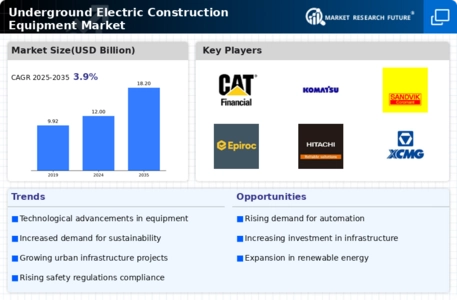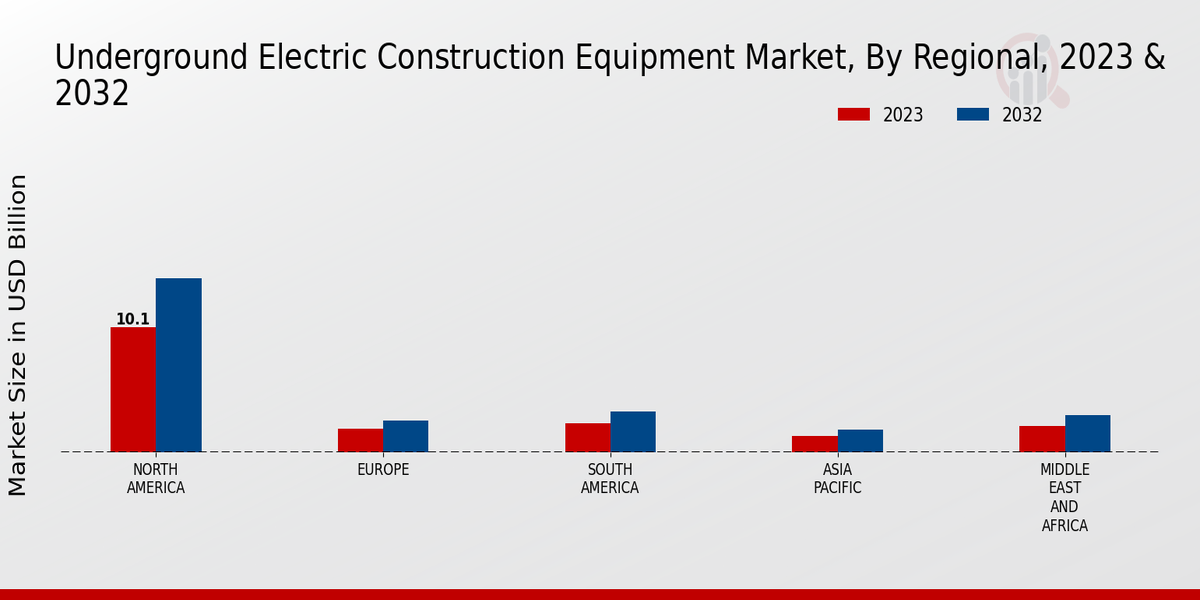Market Growth Projections
The Global Underground Electric Construction Equipment Market Industry is projected to experience substantial growth, with estimates indicating a rise from 12.0 USD Billion in 2024 to 18.2 USD Billion by 2035. This growth trajectory suggests a compound annual growth rate (CAGR) of 3.86% from 2025 to 2035. Such projections highlight the increasing importance of underground electric construction equipment in meeting the demands of modern infrastructure and energy distribution. The market's expansion reflects broader trends in urbanization, technological advancements, and regulatory changes, positioning the industry for a robust future.
Rising Demand for Renewable Energy
The Global Underground Electric Construction Equipment Market Industry experiences a notable surge in demand due to the increasing focus on renewable energy sources. As countries strive to meet their energy needs sustainably, investments in underground electric infrastructure are rising. For instance, the global shift towards wind and solar energy necessitates the installation of extensive underground cabling systems. This trend is projected to contribute significantly to the market, with the industry expected to reach 12.0 USD Billion in 2024. The emphasis on renewable energy not only enhances energy security but also promotes environmental sustainability, thereby driving the growth of the Global Underground Electric Construction Equipment Market.
Government Regulations and Standards
Government regulations and standards significantly influence the Global Underground Electric Construction Equipment Market Industry. Regulatory bodies worldwide are implementing stringent safety and environmental standards for underground construction projects. Compliance with these regulations often necessitates the use of specialized equipment designed to meet safety and operational requirements. For instance, regulations regarding the installation of underground electric systems in urban areas compel contractors to invest in advanced construction equipment. This regulatory landscape not only ensures public safety but also drives market growth as companies seek to adhere to these standards, thereby expanding the demand for underground electric construction equipment.
Technological Advancements in Equipment
Technological innovations play a pivotal role in shaping the Global Underground Electric Construction Equipment Market Industry. The introduction of advanced machinery and tools enhances efficiency and safety in underground construction projects. Innovations such as automated tunneling machines and trenchless technology reduce the time and costs associated with installation. These advancements not only improve operational efficiency but also minimize environmental impact, aligning with global sustainability goals. As the industry embraces these technologies, the market is likely to witness a steady growth rate, with a projected CAGR of 3.86% from 2025 to 2035, indicating a robust future for underground electric construction equipment.
Urbanization and Infrastructure Development
Rapid urbanization across the globe is a critical driver for the Global Underground Electric Construction Equipment Market Industry. As cities expand, the demand for reliable underground electric systems increases to support urban infrastructure. Governments are investing heavily in modernizing their electrical grids and expanding urban facilities, which often requires advanced underground construction equipment. For example, the construction of smart cities necessitates the installation of underground electric networks to facilitate efficient energy distribution. This trend is expected to bolster the market, with projections indicating a growth to 18.2 USD Billion by 2035, reflecting the essential role of underground electric construction in urban development.
Increased Investment in Smart Grid Technologies
The Global Underground Electric Construction Equipment Market Industry is witnessing increased investment in smart grid technologies, which are essential for modernizing electrical infrastructure. Smart grids enhance the efficiency and reliability of electricity distribution, necessitating the installation of advanced underground electric systems. Governments and private sectors are allocating substantial funds to upgrade existing grids and implement smart technologies, which often require specialized underground construction equipment. This trend is expected to propel market growth, as the industry adapts to the evolving energy landscape and seeks to improve grid resilience and performance.


























Leave a Comment